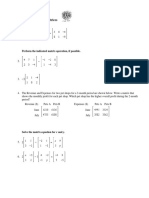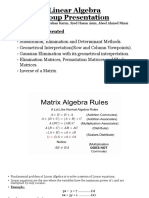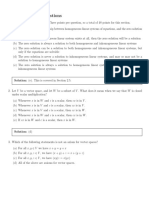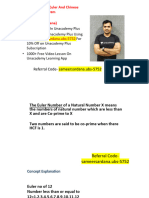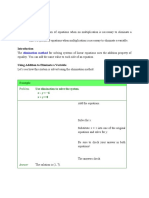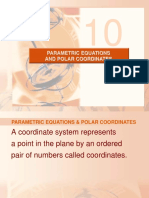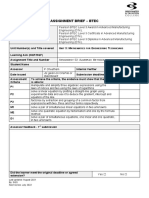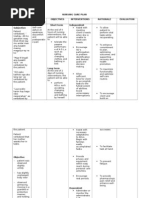Basic Matrix Operations: Example 1)
Basic Matrix Operations: Example 1)
Uploaded by
gaurav775588Copyright:
Available Formats
Basic Matrix Operations: Example 1)
Basic Matrix Operations: Example 1)
Uploaded by
gaurav775588Original Description:
Original Title
Copyright
Available Formats
Share this document
Did you find this document useful?
Is this content inappropriate?
Copyright:
Available Formats
Basic Matrix Operations: Example 1)
Basic Matrix Operations: Example 1)
Uploaded by
gaurav775588Copyright:
Available Formats
Basic Matrix Operations
A matrix is a rectangular or square grid of numbers arranged into rows and columns. Each
number in the matrix is called an element, and they are arranged in what is called an array. The
plural of “matrix” is “matrices”. Matrices are often used in algebra to solve for unknown values
in linear equations, and in geometry when solving for vectors and vector operations.
Example 1) Matrix M M=[ ]
- There are 2 rows and 3 columns in matrix M. M would be called a 2 x 3 (i.e. “2 by 3”) matrix.
PART A - Matrix Addition
We can add matrices together as long as their dimensions are the same, i.e. both matrices
have the same number of rows and columns. To add two matrices, we add the numbers of each
matrix that are in the same element position.
Example 2) [ ] + [ ] = [ ]
- For the elements in bold: 8 + 3 = 11
PART B - Matrix Subtraction
We can subtract matrices in a similar way to addition. Both matrices need to have the same
dimensions, and we subtract the numbers of the second matrix from the first that are in the
same element position.
Example 3) [ ] [ ] = [ ]
- For the elements in bold: 8 - 3 = 5
PART C - Multiplying a Matrix by a Constant
We can multiply a matrix by some value by multiplying each element with that value. The value
can be positive or negative.
Example 4) 2x [ ] = [ ]
1x [ ] [ ]
Example 5) =
Tutoring and Learning Centre, George Brown College YEAR www.georgebrown.ca/tlc
Basic Matrix Operations
- We can get the negative of a matrix by using the above multiplication method:
Example 6) [ ] = [ ]
PART D - Multiplying Matrices
We can multiply a matrix (A) by another matrix (B) if the number of columns in A is equal to the
number of rows in B (in bold). Multiplication of A by B is typically written as A(B) or (A)B.
Example 7) A=[ ] B=[ ]
2x3 3x1
- A has 2 rows and 3 columns and B has 3 rows and 1 column so we can multiply A by B.
Notice that we can’t multiply B by A in this particular case because the number of columns in B
is not equal to the number of rows in A (in bold).
Example 8) B=[ ] A=[ ]
3x1 2x3
- This means that multiplying matrices is not commutative: A(B) ≠ B(A)
To multiply matrices, there’s a convention that is followed.
Let matrix A = [ ] and B = [ ]
A(B) = [ ][ ] = [ ]
- Let’s look at the first row of A and the first column of B. Element a is multiplied by element e.
Element b is multiplied by element g. The value of the element in the first row and first column
of A(B) is the sum of the products (ae + bg).
A=[ ] B=[ ]
Example 9)
2. x 3 3 x 1.
Tutoring and Learning Centre, George Brown College YEAR www.georgebrown.ca/tlc
Basic Matrix Operations
A(B) = [ () ( ) () ] = [ ]
( ) () ( )( )
- Notice A(B) is now a .2 x 1. matrix.
PART E - Transposing a Matrix
To transpose a matrix, we swap the rows for the columns. To indicate that we are transposing a
matrix, we add a “T” to the top right-hand corner of the matrix.
T
Example 10) [ ] = [ ]
Practice Questions
Given the following matrices, please solve the questions below and if you can’t solve the
problem, explain why:
A=[ ] B=[ ] C=[ ] D=[ ] E=[ ]
F=[ ]
1) A + F
2) E – D
3) C + B
4) C(D)
5) A(F)
6) CT
7) FT(E)
Tutoring and Learning Centre, George Brown College YEAR www.georgebrown.ca/tlc
Basic Matrix Operations
Solutions
1) A + F = [ ] [ ] = [ ]
2) E – D = [ ]–[ ] = [ ]
3) C + B = [ ] +[ ]
This problem cannot be solved because the matrices have different dimensions.
4) C(D) = [ ][ ] = [ ]
3x2 2x2 3x2
5) A(F) = [ ][ ]
2x3 2x3
This problem cannot be solved because the number of columns in A does not equal to
the number of rows in F.
T
6) CT = [
] = [ ]
T
7) FT(E) = [ ] [ ] = [ ][ ] = [ ]
3x2 2x2 3x2
Tutoring and Learning Centre, George Brown College YEAR www.georgebrown.ca/tlc
You might also like
- 268 7 TG59DAR71MAT 12020 Assignment Brief HNC CBE Unit 8 Additional Material Final 4No ratings yet268 7 TG59DAR71MAT 12020 Assignment Brief HNC CBE Unit 8 Additional Material Final 423 pages
- Module 1: Systems of Linear Equations: Multiple Choice QuestionsNo ratings yetModule 1: Systems of Linear Equations: Multiple Choice Questions2 pages
- Introduction To Linear Algebra (MATH 202)No ratings yetIntroduction To Linear Algebra (MATH 202)4 pages
- CHAPTER 3 - Matrix Algebra and Applications in Economics & Business To StudentsNo ratings yetCHAPTER 3 - Matrix Algebra and Applications in Economics & Business To Students10 pages
- Lesson 3. Division and Multiplication of Rational Expressions 1No ratings yetLesson 3. Division and Multiplication of Rational Expressions 15 pages
- Unit 1: Measures of Central Tendency: Module 6: Descriptive Statistical MeasuresNo ratings yetUnit 1: Measures of Central Tendency: Module 6: Descriptive Statistical Measures10 pages
- Finding The Determinant by Cofactor ExpansionNo ratings yetFinding The Determinant by Cofactor Expansion2 pages
- Linear Algebra-4G Mid Term Exam Spring 2021No ratings yetLinear Algebra-4G Mid Term Exam Spring 20211 page
- Simplifying and Evaluating Algebraic Expressions: Looking BackNo ratings yetSimplifying and Evaluating Algebraic Expressions: Looking Back27 pages
- Worksheet On Sets Using Venn Diagram - Practice The Different Types of QuestionsNo ratings yetWorksheet On Sets Using Venn Diagram - Practice The Different Types of Questions6 pages
- D. Inverse Trigonometric Functions: One-To-One OntoNo ratings yetD. Inverse Trigonometric Functions: One-To-One Onto69 pages
- Linear Equation Find The Value of X and y From Substitution MethodNo ratings yetLinear Equation Find The Value of X and y From Substitution Method12 pages
- Parametric Equations and Polar CoordinatesNo ratings yetParametric Equations and Polar Coordinates112 pages
- Assignment Brief - Btec: As Given On Onefile or Blackboard As Given On Onefile or Blackboard100% (1)Assignment Brief - Btec: As Given On Onefile or Blackboard As Given On Onefile or Blackboard6 pages
- Number Theory: Bachelor of Secondary EducationNo ratings yetNumber Theory: Bachelor of Secondary Education1 page
- Vectors, Linear Combinations and Linear IndependenceNo ratings yetVectors, Linear Combinations and Linear Independence13 pages
- Five Tips For Improving Your Website ContentNo ratings yetFive Tips For Improving Your Website Content3 pages
- Technical Form-7: Details of The Candidates Trained by The Bidder in Applied TradeNo ratings yetTechnical Form-7: Details of The Candidates Trained by The Bidder in Applied Trade5 pages
- 12-Boot Images and Distribution Point Configuration For OSD in SCCM 2012 R2No ratings yet12-Boot Images and Distribution Point Configuration For OSD in SCCM 2012 R29 pages
- 6-Installing System Center 2012 R2 Configuration ManagerNo ratings yet6-Installing System Center 2012 R2 Configuration Manager15 pages
- Home & Home Office Support Home & Home Office SupportNo ratings yetHome & Home Office Support Home & Home Office Support11 pages
- Adding Drivers To Windows Deployment Services Boot Images - Tristan Watkins On IT InfrastructureNo ratings yetAdding Drivers To Windows Deployment Services Boot Images - Tristan Watkins On IT Infrastructure27 pages
- Features: Windows 8 Is The Tentative Name For The Upcoming Version of TheNo ratings yetFeatures: Windows 8 Is The Tentative Name For The Upcoming Version of The3 pages
- Beauty and Being in Von Hildebrand and TNo ratings yetBeauty and Being in Von Hildebrand and T24 pages
- Acts of Lasciviousness (Criminal Law Book 2)No ratings yetActs of Lasciviousness (Criminal Law Book 2)2 pages
- B. P. Mandal College of Engineering, Madhepura Bihar SyllabusNo ratings yetB. P. Mandal College of Engineering, Madhepura Bihar Syllabus1 page
- Web Results: Accessibility Links Skip To Main Content Accessibility FeedbackNo ratings yetWeb Results: Accessibility Links Skip To Main Content Accessibility Feedback8 pages
- Work Ethics of The Proficient Teachers: Basis For A District Learning Action Cell (LAC) PlanNo ratings yetWork Ethics of The Proficient Teachers: Basis For A District Learning Action Cell (LAC) Plan11 pages
- 268 7 TG59DAR71MAT 12020 Assignment Brief HNC CBE Unit 8 Additional Material Final 4268 7 TG59DAR71MAT 12020 Assignment Brief HNC CBE Unit 8 Additional Material Final 4
- Module 1: Systems of Linear Equations: Multiple Choice QuestionsModule 1: Systems of Linear Equations: Multiple Choice Questions
- CHAPTER 3 - Matrix Algebra and Applications in Economics & Business To StudentsCHAPTER 3 - Matrix Algebra and Applications in Economics & Business To Students
- Lesson 3. Division and Multiplication of Rational Expressions 1Lesson 3. Division and Multiplication of Rational Expressions 1
- Unit 1: Measures of Central Tendency: Module 6: Descriptive Statistical MeasuresUnit 1: Measures of Central Tendency: Module 6: Descriptive Statistical Measures
- Simplifying and Evaluating Algebraic Expressions: Looking BackSimplifying and Evaluating Algebraic Expressions: Looking Back
- Worksheet On Sets Using Venn Diagram - Practice The Different Types of QuestionsWorksheet On Sets Using Venn Diagram - Practice The Different Types of Questions
- D. Inverse Trigonometric Functions: One-To-One OntoD. Inverse Trigonometric Functions: One-To-One Onto
- Linear Equation Find The Value of X and y From Substitution MethodLinear Equation Find The Value of X and y From Substitution Method
- Assignment Brief - Btec: As Given On Onefile or Blackboard As Given On Onefile or BlackboardAssignment Brief - Btec: As Given On Onefile or Blackboard As Given On Onefile or Blackboard
- Vectors, Linear Combinations and Linear IndependenceVectors, Linear Combinations and Linear Independence
- Technical Form-7: Details of The Candidates Trained by The Bidder in Applied TradeTechnical Form-7: Details of The Candidates Trained by The Bidder in Applied Trade
- 12-Boot Images and Distribution Point Configuration For OSD in SCCM 2012 R212-Boot Images and Distribution Point Configuration For OSD in SCCM 2012 R2
- 6-Installing System Center 2012 R2 Configuration Manager6-Installing System Center 2012 R2 Configuration Manager
- Home & Home Office Support Home & Home Office SupportHome & Home Office Support Home & Home Office Support
- Adding Drivers To Windows Deployment Services Boot Images - Tristan Watkins On IT InfrastructureAdding Drivers To Windows Deployment Services Boot Images - Tristan Watkins On IT Infrastructure
- Features: Windows 8 Is The Tentative Name For The Upcoming Version of TheFeatures: Windows 8 Is The Tentative Name For The Upcoming Version of The
- B. P. Mandal College of Engineering, Madhepura Bihar SyllabusB. P. Mandal College of Engineering, Madhepura Bihar Syllabus
- Web Results: Accessibility Links Skip To Main Content Accessibility FeedbackWeb Results: Accessibility Links Skip To Main Content Accessibility Feedback
- Work Ethics of The Proficient Teachers: Basis For A District Learning Action Cell (LAC) PlanWork Ethics of The Proficient Teachers: Basis For A District Learning Action Cell (LAC) Plan









